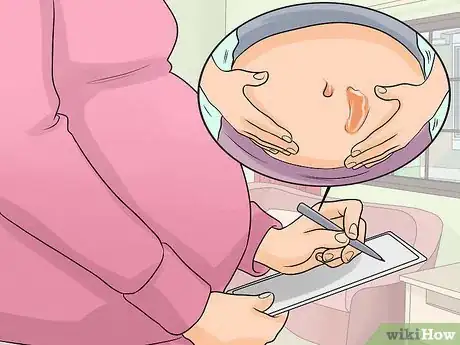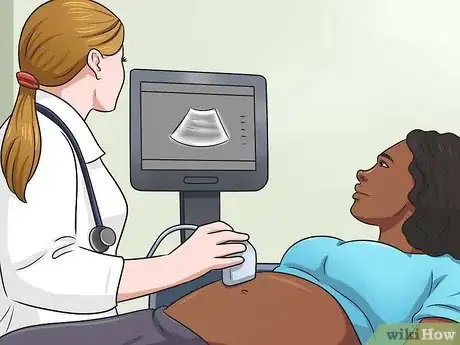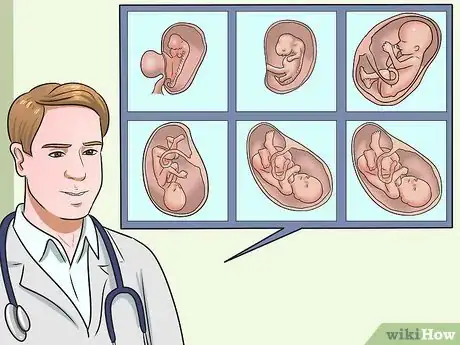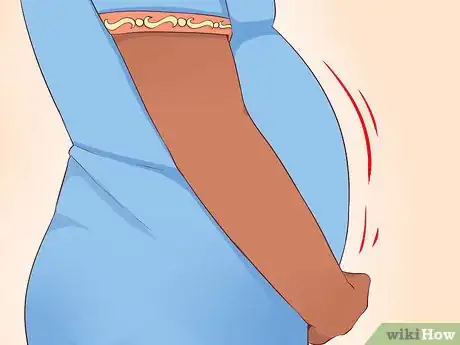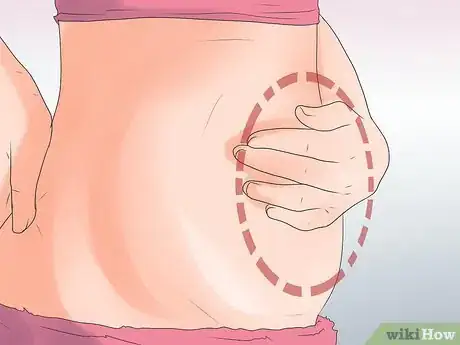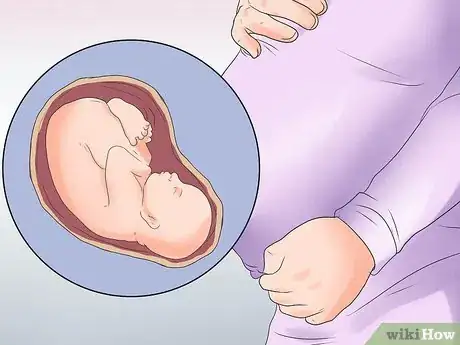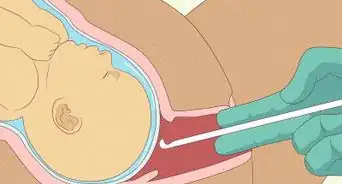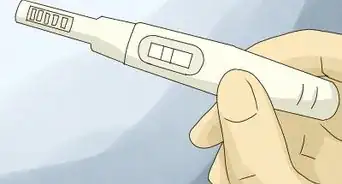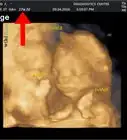This article was medically reviewed by Jennifer Boidy, RN. Jennifer Boidy is a Registered Nurse in Maryland. She received her Associate of Science in Nursing from Carroll Community College in 2012.
There are 7 references cited in this article, which can be found at the bottom of the page.
wikiHow marks an article as reader-approved once it receives enough positive feedback. In this case, 93% of readers who voted found the article helpful, earning it our reader-approved status.
This article has been viewed 245,958 times.
Your baby will do lots of twisting and turning while they’re in the womb! It can be a fun and magical experience feeling your baby’s movement, and exciting to try to determine what positions they settle into. Whether you’re simply curious or you’re approaching your delivery date, there are both medical ways and at-home methods to tell your baby’s position in the uterus – though some are more accurate than others. Try some out, and if in doubt, ask your doctor or midwife for help.
Steps
Exploring Your Belly and Noting What You Feel
-
1Keep a movement journal. It might be fun to be able to look back at all the different positions your baby was in during your pregnancy. Keep a diary, journal, or notebook to document this. Write down the date, how far along in your pregnancy you are, and what position your baby is in any time you get the chance.
-
2Feel your belly to locate the hard lumps. Though it’s not an exact science, you may be able to locate your baby’s head or bottom just by feeling your stomach. Press gently, and try to relax while you do it – press down while you exhale. A hard, round bump like a small bowling ball is probably the baby’s head; a round but somewhat softer bump may be their bottom. Use some of these standard guidelines to estimate your baby’s position:[1]
- Do you have a lump on the right or left side of your belly? Press it gently – if the whole baby moves, they might be in a head-down (cephalic) position.
- Feeling a hard, rounded lump beneath your ribs might be the baby’s head, meaning they’re in breech (head up) position.
- If the two round, hard areas (the head and bottom) are at the sides of your belly, your baby may be lying horizontally. Babies usually move themselves out of this position by 8 months.[2]
-
3Pinpoint where you feel kicking. Babies kick, and it can be one of the easiest ways to visualize how they’re oriented in your uterus. If you feel kicking above your belly button, the baby is probably in a head down position. If the kicking is below your belly button, the baby is probably head up. Just visualize where the baby's feet and legs might be based on where you feel kicking.[3]
- If you feel kicking around the front middle of your belly, the baby may be in a posterior position – head down with their back to your back. Your stomach may also look more flattened than rounded in this position.
Using Medical Practices
-
1Ask your healthcare provider to show you how to feel the baby. Trained professionals can often tell what position the baby is in just by feeling your abdomen. The next time they do this, ask them to guide you through it. They can offer tips and advice on what to feel for at home![4]
- Ask to feel along with them as they do it so you can get familiar with how different parts of your baby feel from outside your uterus.
-
2Listen for the baby’s heartbeat. Though it won’t tell you everything about the baby’s position, finding the baby’s heart can give you some indication of how they are lying. If you happen to have a fetoscope or stethoscope at home, use it to listen on your belly. If not, ask your partner or a loved one to put their ear to your stomach in a quiet room. You can usually hear the heartbeat this way in the last two months of pregnancy – though exactly locating the heart might be difficult.[5] Move around to different spots to see where the heartbeat is loudest and clearest.
- If the heartbeat is loudest below mom’s belly button, the baby is probably head down; above the belly button, head up.
- Try listening through a toilet paper roll to amplify the sounds!
-
3Get an ultrasound. Ultrasound scans are the only way to tell for sure what position your baby is in. Ultrasounds use sound waves to make a picture of your baby in the womb. Schedule regular ultrasounds with your OB/GYN or midwife to check up on your baby, or simply to determine how they are lying in your uterus.[6]
- Schedule an ultrasound in your first trimester and again in your second trimester, or more frequently if your baby's health needs to be monitored. Ask your healthcare provider for details about when to get an ultrasound.
- Newer ultrasound technology can make amazingly clear images of the baby, though not all offices have these.
Trying Belly Mapping
-
1Gather your materials. Belly mapping might be a challenge, but it’s a fun challenge. In your 8th months of pregnancy, try belly mapping right after you see your healthcare provider for an ultrasound or fetal heart monitoring. Go home and gather some non-toxic paint or markers and a doll with moveable limbs.
-
2Find the baby's head. Lie down on your back where you'll be comfortable, and lift your shirt. Use firm pressure and feel around your pelvic area for a hard, round shape. Use your art materials to draw a circle for your baby’s head.[7]
-
3Locate the baby's heartbeat. Draw a heart over the area of your baby’s heartbeat – your healthcare provider probably just showed you where this is at your appointment. If not, use a stethoscope or fetoscope if you have one, or ask a loved one to put their ear to your belly and tell you where the heartbeat is the loudest.[8]
-
4Feel for the baby's bottom. Gently feel around for your baby’s bottom, which will be hard and round, but softer than the head. Mark this on your belly.[9]
-
5Color in any other spots you can feel. A long, flat area may be the baby’s back; knobbly points could be knees or elbows. Think about where you’ve been feeling kicking. Mark any other landmarks you can find.[10]
-
6Place your doll in different positions. Start to play around with your doll, moving it into possible positions based on where your baby’s head and heart are. This can help you visualize your baby’s position better!
-
7Get creative if you want to. Draw or paint your baby like an art project, or do some fun photography. This can be a great keepsake.
Warnings
- Make a plan with your doctor or midwife if you’re close to delivery and your baby is in breach or transverse (horizontal) position. These may require a C-section if the baby can’t be moved into a better position for birth.⧼thumbs_response⧽
- If you’re feeling around for your baby’s position and have a Braxton-Hicks contraction, stop and wait for it to pass. It’s not harming you or your baby, but you won’t be able to feel the baby until it’s over.⧼thumbs_response⧽
- It’s a good idea to start monitoring your baby’s movements starting in your 28th week of pregnancy. You should typically feel about 10 kicks or other movements over the course of 2 hours. If you don’t feel that many movements, don’t panic – just wait a few hours and try again. If you still don’t feel 10 kicks during your second count, call your OB-GYN.[13]⧼thumbs_response⧽
References
- ↑ https://www.nct.org.uk/labour-birth/getting-ready-for-birth/baby-positions-womb-birth
- ↑ http://www.open.edu/openlearncreate/mod/oucontent/view.php?id=41&printable=1
- ↑ https://www.babycentre.co.uk/x25015775/can-i-tell-how-my-babys-lying-based-on-his-movements
- ↑ https://www.babycentre.co.uk/x25015775/can-i-tell-how-my-babys-lying-based-on-his-movements
- ↑ http://www.open.edu/openlearncreate/mod/oucontent/view.php?id=41&printable=1
- ↑ https://www.nhs.uk/pregnancy/your-pregnancy-care/ultrasound-scans/
- ↑ https://www.babycentre.co.uk/x25015775/can-i-tell-how-my-babys-lying-based-on-his-movements
- ↑ https://www.whattoexpect.com/pregnancy/fetal-development/fetal-heart-heartbeat-circulatory-system/
- ↑ https://www.nct.org.uk/labour-birth/getting-ready-for-birth/baby-positions-womb-birth
About This Article
To tell the position of your baby in your uterus, try pressing down gently on your belly while you exhale. If you feel a hard, round bump like a small bowling ball, this is probably your baby’s head, while a softer bump may be their bottom. Depending on where their head is, you should be able to work out your baby’s position. Alternatively, pay attention to your baby’s kicking, since this can also indicate its orientation. For example, if your baby kicks below your belly button, it’s probably head up and if it kicks above your belly button, it’s probably head down. For more tips from our Medical co-author, including how to listen for your baby’s heartbeat to determine its position, read on!


